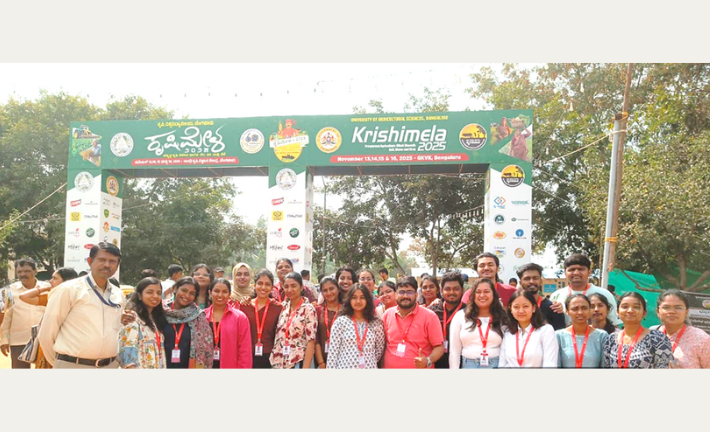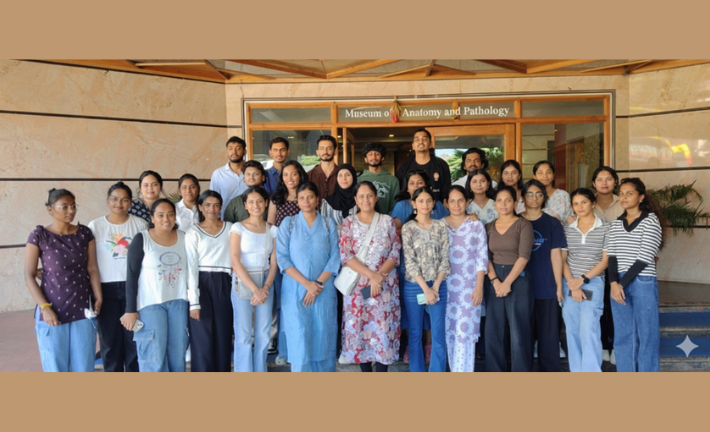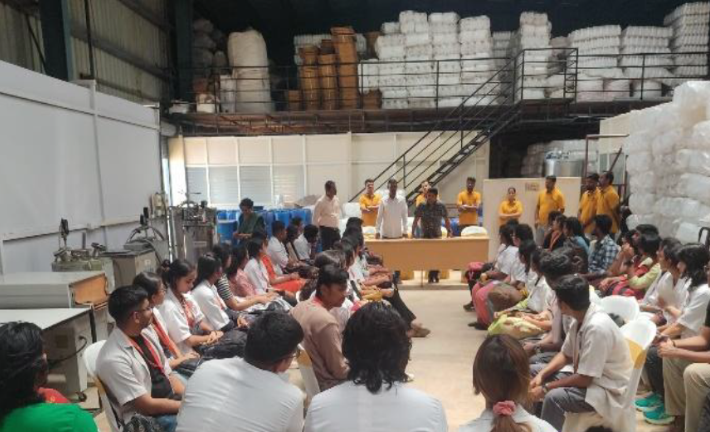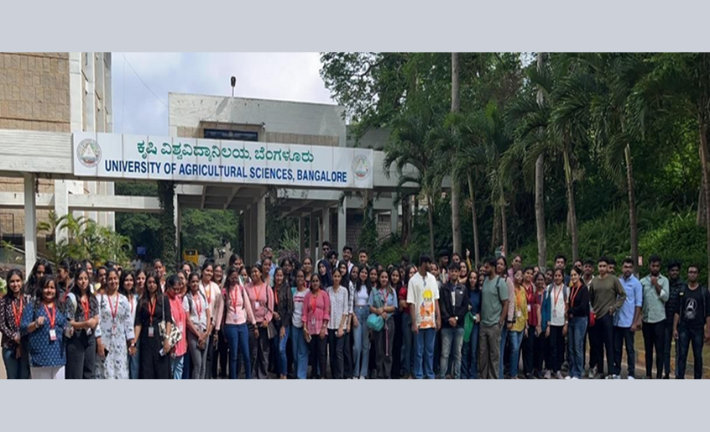msc Industrial Visits
Industrial Visit

Krishimela 2025: A Platform for Agricultural Learning
MSc Biotechnology students visited Krishimela 2025 at GKVK, Bengaluru, on 14 November 2025 accompanied by faculty members Dr. Lakshimikanth R. N. and Dr. Sathish Babu. The visit aimed to provide students with practical exposure to recent advancements in agriculture, including innovative crop varieties, modern farm implements, organic inputs, precision farming tools, and sustainable farming technologies. Students explored various exhibition stalls, observed live demonstrations such as drone-based spraying, automated irrigation, and hydroponics systems, and interacted with scientists, extension personnel, and agri-entrepreneurs. The visit significantly enhanced their understanding of contemporary agricultural practices, climate-resilient technologies, and opportunities in the agri-business sector. Overall, it proved to be an enriching and educational experience for all participants.
The course begun with the introduction of the students and about their area of interest including academics, sports and extra circular activities.
During the course, the faculty member of BA department briefed the students about their respective subjects and helped them understand the basics of each subjects.

Industrial Trip for MSc Biotechnology III Semester students
As part of the academic curriculum, the M.Sc. Biotechnology III Semester students visited the Manipal Museum of Anatomy and Pathology, Aqua Blue Pure Water Packaging Industry, and Sri Ganesh Cashew Industry during their industrial tour from 23rd to 27th November 2025, capturing group photographs in front of each establishment. The students were accompanied by Dr. Sowbhagya R and Dr. Muktha H, Asst. Professor, Dept. of Biotechnology. The visit provided valuable exposure to industrial workflows, processing technologies, and scientific displays, offering students an opportunity to connect theoretical learning with real-world applications.

Field visit to NCR Farm in Nagadasanahalli, Yelahanka, Bengaluru
The Department of Biotechnology and Genetics at M.S. Ramaiah College of Arts, Science and Commerce organized a field visit for M.Sc. Biotechnology III Semester students to NCR Farm in Nagadasanahalli, Yelahanka, Bengaluru on September 20, 2025. The visit, facilitated by the S.O. Technology Club, provided students with practical exposure to horticultural techniques and highlighted advancements from traditional to modern practices, bridging technology and tradition. Participants gained valuable insights into various biotech-driven approaches in crop management, plant tissue culture, and the importance of hands-on research in shaping future careers, reinforcing the department’s commitment to experiential learning and professional preparedness.

A Blooming Experience in Floriculture
The Department of Biotechnology and Genetics at M.S. Ramaiah College of Arts, Science & Commerce organized a field visit titled "A Field Visit to Unravel the Nature’s Classroom" on August 25, 2025, at Srikanth Bollapally Floriculture Farm in Tubagere, Bengaluru. During the program, undergraduate life science students gained firsthand insights into floriculture farming, building confidence and independence as they encountered new environments and challenges. The experience fostered lifelong learning by making education hands-on and engaging, with students developing essential practical skills, teamwork, and communication through interaction with peers, teachers, and field experts. The event, coordinated by Dr. Radha Dayanidhi and Dr. Pramod Prakash Desai alongside a dedicated committee, demonstrated the college’s ongoing commitment to connecting classroom learning with real-world applications and inspiring deeper curiosity in the life sciences.

From Campus to Chromosomes: A Day at Promolecular Sciences
The Department of Biotechnology & Genetics organized an industrial visit on May 16, 2025, for final-year BSc Life Science students to Promolecular Sciences Pvt Ltd, Bengaluru. Students explored R&D activities including automated gene synthesis, diagnostic kit development, and plant health testing. The visit offered valuable insights into lab automation, industrial biotechnology, and career opportunities in biotech and consultancy.

From Lab to Land: Industrial Exposure at Miklens Bio Pvt. Ltd
TAn industrial visit to Miklens Bio Pvt. Ltd., Bengaluru was organized on 8 April 2025 for B.Sc. VI semester students by the Department of Biotechnology & Genetics, MSRCASC. The visit provided practical exposure to bioprocess technology, industrial-scale fermentation, and sustainable agricultural biotechnology. Students gained insights into the R&D, production, quality control, and regulatory standards involved in developing biopesticides, biofertilizers, and biostimulants. Special emphasis was given to NKP1166 growth enhancer and GoWeed, India’s first OMRI-approved bioherbicide. Interaction with industry experts enriched students’ understanding of product development and commercialization. Overall, the visit effectively bridged academic learning with real-time industrial applications in agricultural biotechnology.

Exploring Sustainable Wastewater Treatment Systems
As part of their curriculum, I Year B.Sc. Biotechnology students from Ramaiah College of Arts, Science & Commerce visited the 4 MLD Wastewater Treatment Plant at Cubbon Park on 29th April and 2nd May 2025. The visit offered practical exposure to sewage treatment processes and highlighted the role of biotechnology in environmental sustainability.
Students observed each stage—from preliminary screening and biological digestion to chlorination and odor control—and learned about Membrane Bioreactor (MBR) technology and SCADA-based automation. The recycled water from this plant is used for irrigating Cubbon Park and watering Vidhana Soudha and Raj Bhavan, promoting water conservation.
The visit deepened students’ understanding of microbial action in waste degradation and biotechnology's real-world environmental applications. The visit was thoughtfully arranged by Dr. Sathish Babu and Dr. Vijayalakshmi, Assistant Professors, Department of Biotechnology.

Industrial visit to Goa
The MSc III Semester Biotechnology students of M S Ramaiah College of Arts, Science, and Commerce from January 28 to February 1, 2024 embarked on an insightful industrial visit to Goa, exploring key research and industrial sites. The visit included the National Institute of Oceanography in Dona Paula, where students learned about marine science research; the Indian Coastal Agricultural Research Institute in Old Goa, which highlighted advancements in coastal agriculture and sustainable farming techniques; the Goa waste management Corporation, where the students gained insights into management of waste, and lastly visited the microbiology and biotechnology departments of Goa University. The visit offered students a deeper understanding of real-world applications of biotechnology in diverse fields, enhancing their academic learning with hands-on exposure.
The course begun with the introduction of the students and about their area of interest including academics, sports and extra circular activities.
During the course, the faculty member of BA department briefed the students about their respective subjects and helped them understand the basics of each subjects.

GKVK campus
On July 5, 2024, B.Sc. VI Semester students visited the GKVK campus of the University of Agricultural Sciences, Bengaluru, to gain practical exposure to various disciplines in agricultural sciences. The visit covered the Departments of Biotechnology, Food and Nutrition, and Apiculture, each offering valuable insights through demonstrations and interactive sessions.
At the Biotechnology Department, students explored advanced research and instrumentation laboratories, learning about ongoing work in genetic engineering and molecular biology. They were introduced to key instruments such as PCR machines, spectrophotometers, and centrifuges, and observed transgenic plants developed for improved agricultural traits.
The Food and Nutrition Department focused on food safety and quality assessment, showcasing techniques like chromatography, ELISA, and microbial testing. The visit concluded at the Apiculture Department, where students learned about bee biology, honey production, and observed live field demonstrations. Overall, the visit enriched students’ understanding of applied agricultural sciences.

Field visit to Bangalore Bioinnovation Center
On 29th August 2024, II Year M.Sc. Biotechnology students visited the Bangalore Bioinnovation Center, Electronic City, to gain industry-oriented exposure in biotechnology. The visit provided students with valuable insights into cutting-edge research, innovation, and entrepreneurship in the biotech sector.
Students participated in a guided tour of advanced laboratories and research facilities, followed by expert talks highlighting recent biotechnological advancements, ethical considerations, and societal impact. Interactive Q&A and networking sessions with professionals offered clarity on real-world applications and potential career pathways in biotechnology.
The visit enriched students’ understanding of industry practices, advanced technologies, and emerging opportunities, inspiring them to explore biotechnology as a dynamic academic and career choice.

Krishimela 2024: A Platform for Agricultural Learning
M.Sc. Biotechnology students visited Krishimela 2024 at GKVK, Bengaluru, on 15 November 2024, accompanied by faculty members. The visit was organized to provide students with practical exposure to recent advancements in agriculture, including innovative crop varieties, modern farm implements, organic inputs, precision farming tools, and sustainable farming technologies.
Students explored various exhibition stalls, witnessed live demonstrations such as drone-based spraying, automated irrigation, and hydroponics systems, and interacted with scientists, extension personnel, and agri-entrepreneurs. The visit enhanced students’ understanding of contemporary agricultural practices, climate-resilient technologies, and emerging opportunities in the agri-business sector. Overall, the experience proved to be informative, engaging, and academically enriching.
.png)